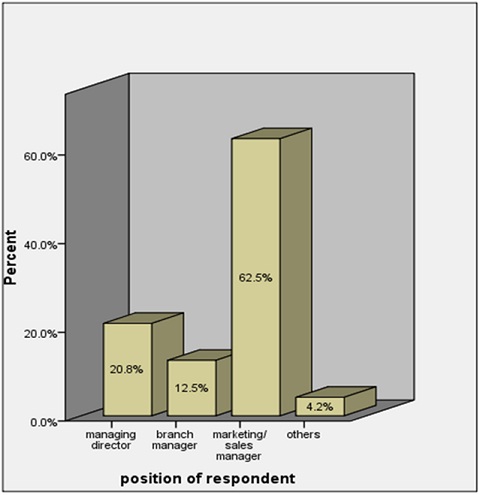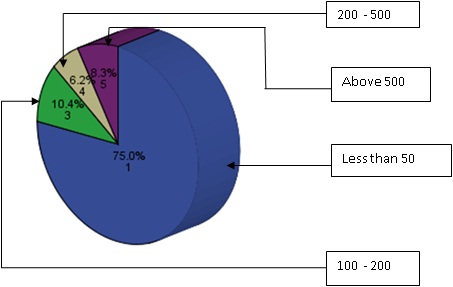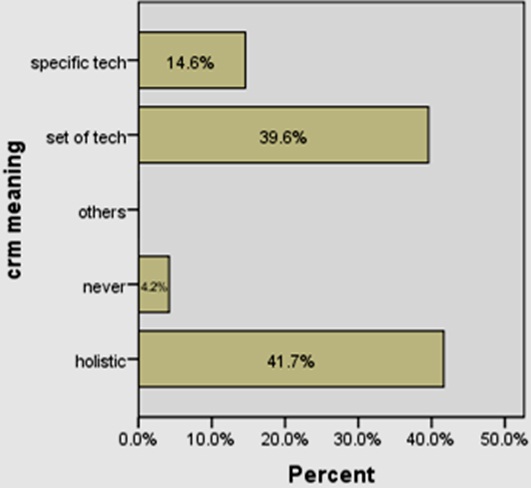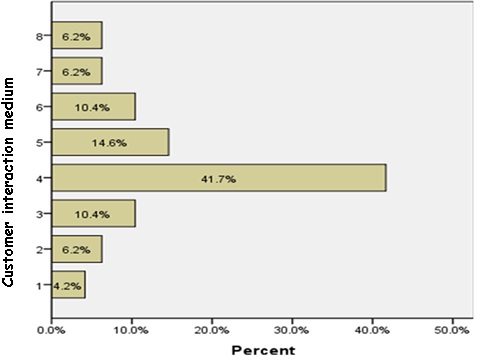Microfinance industry in Cameroon and CRM implementation
Chapter 4 : PRESENTATION AND ANALYSIS OF DATA
4.1 Introduction
This Chapter intends to present analyses conducted on the responses from the survey instrument (questionnaire) with the use of SPSS.
To do so, the author will analyze the characteristics of the respondents and classify all the 16 questions included in the questionnaire under the following sub-headings into the analyses are done
4.2 Characteristics of Respondents
As pointed out in Chapter 3 (Methodology), the sample population was structured in such a way that it covered all the main MFIs of the country.
Due to time constraint, cost, and the necessity to cover all these companies in the country, since the use of CRM is meant to cover the entire microfinance industry in Cameroon, the author was obliged to group all the regions into 3 categories according to MFIs categories such as:
- The First Category of MFIs (1) that deal with their members (Cooperatives, associations, etc.);
- The Second Category of MFIs (2) that provide finance services to people. They however act as Limited Companies;
- The Third Category of MFIs (3) that only provide loans but must not collect savings.
A total of 100 (seventy questionnaires) were distributed to different respondents.
Overall, with a percentage of 41.0% the Second Category of MFIs produced the most respondent feedback, followed by the Third Category with 37.0%, and the First one with 22.0%
Final Questionnaire usability based on responses from the three categories
| Category | Category Code | Sample Size Sent Out | Number of Respondents Returned | Number of Useable Response | Percentage of Effective Sample (%) |
| First | 1 | 22 | 18 | 12 | 54.54 |
| Second | 2 | 41 | 34 | 28 | 68.29 |
| Third | 3 | 37 | 33 | 27 | 72.97 |
| TOTAL | 100 | 85 | 67 | 67.0% | |
Table 4.1: Distribution of usable responses corresponding to the category
Briefly, 100 questionnaires were sent out of which 85 was returned. If meant in percentage, 85% of the questionnaires were returned.
Amongst the 85 returned questionnaires, only 67 were useful to analyse.
The remaining 18 were improperly filled and consequently not fit to the employed. The percentage of response sample is 67.0%.
In effect, the results in the analysis with respect to each question contained in the questionnaire were based on this 67.0%.
Table 4 above presents the full details.
![]()
% of Effective Sample = 67 X 100 = 0.67 ≡ 67.0%
100
4.3 General Information
Some questions (1,2, 3, 8) intended to get specific information about the respondents.
This section is focused on how the responses were employed to answer those questions.
4.3.1 Position of Respondents

Figure 4.1: Position of Respondents expressed in percentage
Among the respondents’ categories that were involved in the research survey, those in charge of Marketing had the highest turn-out with 41.37%, followed by the Managing Director with 23.63%, the IT/IS Manager with 19%, the Branch Manager with 9.64%, and others with 6.36%.
We noticed that microfinance companies get each a Marketing Department in charge of defining the strategy for gaining customer loyalty and satisfaction.
4.3.2 Number of Employees in the Company
75% of the microfinance consists of less than 50 employees. 32.8% of the microfinance consists of 50-100 employees.
6.2% consist of 200-500 employees, while none was recorded for above 500 categories.
Figure 4.3 below shows the representation of the findings.

Figure 4.2: Microfinance sizes expressed in terms of their employees numbers
4.3.3 Perception on CRM Meaning
This question was introduced to know the perception of respondents in defining the meaning of CRM.
Results show that 41.7% of them defined it to be a general/holistic approach to managing the whole business strategy that is driven customer relationship 39.6% of respondents defined it as a set of technologies and methodologies for handling customer relationships 4.2% claimed not to have heard anything about CRM.
In nutshell, based on the findings, CRM is a familiar tool within the Cameroon microfinance industry although it is not well widespread over all of them.

Figure 4.3: Perception of Respondents on CRM definition
4.3.4 Categorization of Companies in terms of CRM Implementation Stage
From the result obtained, the author noticed that 51.1% of the respondents are still considering on the need to implement CRM in their microfinance institutions while 36.3% of them have implemented CRM.
The lowest percentage respondents still do not see the need for implementing it10.6% of them fall into this category.
The reason why the highest percentage of respondents is still considering the need for it could have been affected by weaknesses of Cameroon’s business environment.
Figure 4.5 overleaf shows the result as expressed in percent

Figure 4.4: Percentage Representation of Enterprise Position on CRM implementation
4.3.5 Medium Used to Interact with Customer in terms of Services and Feedback
Figure 4.6 overleaf shows the different means through which microfinance operators interact with their customers.
Among the four options (E-mail, SMS, Interactive voice response…) provided, most of the respondents prefer to interact with their customers through email.
The percentage of respondents in this category is 41.7%.
The result shows that most of the microfinance institutions still interact with their customers more of frontline assistance than through effective use of technology (through their company’s website).
The reason for this high record of respondents that belong to the 41.7% might be unconnected with the result of section 4.3.2 above which shows that most of the microfinance have less than 50 numbers of employees, therefore they are small in size.
Figure 4.5 below shows the result.

Figure 4.5: Medium through which Companies interact with their customers.
To simplify how the interpretation of the result in this section can be analyzed using a quantitative means instead of qualitative, the results under the variable “customer interaction medium” in terms of respondents answers were re-labelled using numbers 1,2,3…etc.
A detail on how this variable was re-labelled in line with the question’s alternatives is shown below
